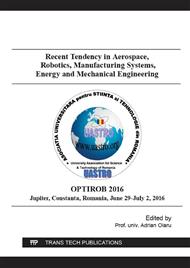[1]
F. C. Zagare and D. M. Kilgour: Perfect Deterrence, Cambridge, Cambridge University Press (2000).
Google Scholar
[2]
Victor Nitu: Electromagnetic Field Exposure from GSM and UMTS Indoor Base Stations, (Applied Mechanics and Materials, OPTIROB 2013).
DOI: 10.4028/www.scientific.net/amm.332.98
Google Scholar
[3]
Muhammad Ushaq, Fang Jian Cheng, Ali Jamshaid: A Fault Tolerant SINS/GPS/CNS Integrated Navigation Scheme Realized through Federated Kalman Filter, (Applied Mechanics and Materials, OPTIROB 2013).
DOI: 10.4028/www.scientific.net/amm.332.104
Google Scholar
[4]
F. C. Zagare and D. M. Kilgour: Assessing Competing Defense Postures: The Strategic Implications of Flexible Response, (World Politics, 47, number 3, 1995).
DOI: 10.1017/s0043887100016439
Google Scholar
[5]
F. C. Zagare: NATO, Rational Escalation and Flexible Response, (Journal of Peace Research, 29, number 4, 1992).
DOI: 10.1177/0022343392029004006
Google Scholar
[6]
P. M. Morgan: Deterrence Now, Cambridge, Cambridge University Press (2003).
Google Scholar
[7]
F. C. Zagare: Rationality and Deterrence, (World Politics, 42, number 2, 1990).
Google Scholar
[8]
F. C. Zagare: The Dynamics of Escalation, (Information and Decision Technologies, 16, number 3, 1990).
Google Scholar
[9]
J. Carr: Inside Cyber Warfare: Mapping the Cyber Underworld, Sebastopol, O'Reilly Media; 2nd edition (2011).
Google Scholar
[10]
E. G. Amoroso: Cyber Attacks Protecting National Infrastructure, Burlington, Elsevier Inc. (2011).
Google Scholar
[11]
J. L. Bayuk, J. Healey, et. all: Cyber Security Policy Guidebook, New Jersey, John Wiley & Sons, Inc. (2012).
Google Scholar
[12]
J. Andress, S. Winterfeld, et. all: Cyber Warfare Techniques, Tactics and Tools for Security Practitioners, Waltham, Elsevier, Inc. (2011).
Google Scholar
[13]
Ting Liu et, all.: Abnormal traffic-indexed state estimation: A cyber–physical fusion approach for Smart Grid attack detection, (Future Generation Computer Systems, Volume 49, 2015).
DOI: 10.1016/j.future.2014.10.002
Google Scholar
[14]
Gary Lilienthal and Nehaluddin Ahmad: Cyber-attack as inevitable kinetic war, (Computer Law & Security Review, Volume 31, Issue 3, 2015).
DOI: 10.1016/j.clsr.2015.03.002
Google Scholar
[15]
Béla Genge, István Kiss and Piroska Haller: A system dynamics approach for assessing the impact of cyber attacks on critical infrastructures, (International Journal of Critical Infrastructure Protection, In Press, Corrected Proof, Available online 1 May 2015).
DOI: 10.1016/j.ijcip.2015.04.001
Google Scholar
[16]
Noam Ben-Asher and Cleotilde Gonzalez: Effects of cyber security knowledge on attack detection, (Computers in Human Behavior, Volume 48, 2015).
DOI: 10.1016/j.chb.2015.01.039
Google Scholar
[17]
W. L. Pritchett and D. De Smet: Kali Linux Cookbook, Birmingham, Packt Publishing, (2013).
Google Scholar
[18]
T. Heriyanto, L. Allen and S. Ali: Kali Linux: Assuring Security By Penetration Testing, Birmingham, Packt Publishing (2014).
Google Scholar
[19]
Horatiu Moga, Mircea Boscoianu, Delia Ungureanu, Ramona Lile, Nurettin Erginoz: Massive Cyber-attacks Patterns Implemented with BDI Agents, (Applied Mechanics and Materials, ICMERA 2015).
DOI: 10.4028/www.scientific.net/amm.811.383
Google Scholar
[20]
J. Muniz and A. Lakhani: Web Penetration Testing with Kali Linux, Birmingham, Packt Publishing (2013).
Google Scholar
[21]
F. Squazzoni: Agent-Based Computational Sociology, West Sussex, John Wiley & Sons Ltd. (2012).
Google Scholar
[22]
M. d'Inverno M. Luck: Understanding Agent Systems, Springer-Verlag Berlin, 2nd edition, (2004).
Google Scholar


